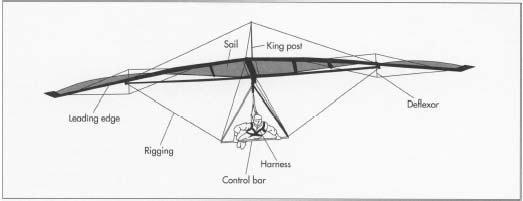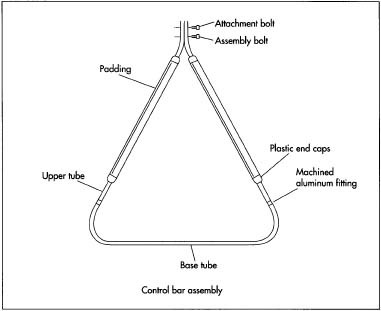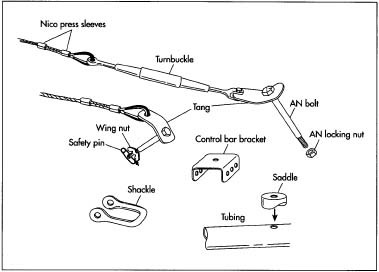Hang Glider
Background
A hang glider is an unpowered heavier-than-air flying device designed to carry a human passenger who is suspended beneath its sail. Unlike other gliders that resemble unpowered airplanes, hang gliders look like large kites. Other gliders are usually towed by a car a airplane or otherwise launched into the air from the ground. Hang gliders, on the other hand, are usually launched from a high point and allowed to drift down to a lower point.
History
Human beings have attempted to fly using devices similar to hang gliders for at least one thousand years. Oliver of Malmesbury, an English monk, is said to have leapt from a tower with wings made of cloth in the year 1020. He supposedly glided for about 600 ft (180 m) before landing and breaking both legs. Similar brief flights are said to have been made in Constantinople in the eleventh century and in Italy in 1498. The Italian artist and scientist Leonardo da Vinci made detailed sketches of various flying machines, but these devices were never built.
The modern history of gliding begins with the English inventor Sir George Cayley. By 1799, Cayley had established the basic design for gliders that is still used today. In 1804, he flew his first successful model glider. In 1853, Cayley achieved the first successful human glider flight with a device that carried his coachman several hundred feet.
The next important pioneer in glider research was the German inventor Otto Lilienthal. In the 1890s, Lilienthal built 18 gliders, which he flew himself. He also kept detailed records of his work, influencing later inventors. After making more than two thousand successful flights, Lilienthal was killed in a crash in 1896.
Inspired by Lilienthal, the American engineer Octave Chanute and his assistants made about two thousand glider flights from sand dunes on the shores of Lake Michigan at the turn of the century. Chanute's work had an important influence on Orville and Wilbur Wright, who invented powered flight soon after. The rapid development of powered flight in the twentieth century led to a decreased interest in gliders until after World War II. At this time, light, smooth wings made of fiberglass were developed for gliders.
The most important innovation in the development of the hang glider was made by the American inventors Gertrude and Francis Rogallo. In 1948, the Rogallos applied for a patent for a flexible kite called a para-wing. Unlike other kites, the Rogallo design had no rigid supports. Instead, it remained limp until it was given firm but temporary shape by the wind in flight. The development of Mylar, an extremely light, strong plastic, improved the performance of the Rogallo kite.
In the late 1950s, the United States government took an interest in the Rogallo design for use in parachutes designed to return spacecraft to Earth. Experiments were also made in building large powered Rogallo kites for military transportation. Inspired by reports of these experiments, the American engineer Thomas Purcell build a 16 ft (4.9 m) wide Rogallo glider with an aluminum frame, wheels, a seat to hold a passenger, and basic control rods in 1961. This was the first true hang glider. Early hang gliders were also built in the United States from bamboo by Barry Hill Palmer in 1961 and in Australia from aluminum by John Dickenson in 1963.
Although the United States government abandoned using the Rogallo design for spacecraft parachutes in 1967, hang gliders using the same design became popular in the 1970s. In 1971, the United States Hang Gliding Association was formed. While California is the favored spot for hang gliders of the West, Dunlap, Tennessee, claims to be the hang gliding capital of the eastern United States, thanks to its location high atop the Cumberland Plateau. Over the next several years, hang gliding became less of a dangerous fad and more of a serious sport. Seven fatalities from hang gliding were reported in 1995, compared to 40 in 1974.
Raw Materials
A hang glider consists of a wing, a frame, cables, and items to hold these parts in place. The wing, also known as the sail, is made from a strong, light plastic. Usually a polyester cloth is used. Polyesters are polymers—they are large molecules made by linking many small molecules together. Polyesters are usually derived from ethylene glycol and terephthalic acid, or similar chemicals. The most common polyester for use in making hang gliders is polyethylene terephthalate, known by the trade name Dacron.
The frame of a hang glider, also known as the airframe, is made from an alloy of aluminum and other metals, such as magnesium, zinc, and copper. The cables and the parts that hold the hang glider together are made of stainless steel. Stainless steel is an alloy of iron, a small amount of carbon, and 12-18% chromium.

Samuel Langley was born in Roxbury, Massachusetts, in 1834. As a child, Langley became interested in studying the stars and, despite that fact that he never attended college, went on to become a professor of astronomy and physics. Langley made many contributions to the field of astronomy, one of the most significant being the invention of the bolometer—an instrument able to detect and measure electromagnetic radiation.
While serving as secretary of the Smithsonian Institute, Langley developed an interest in aeronautics and obtained a $50,000 grant from the United States War Department to study the possibility of manned flight. He began building large, steam-powered models of an aircraft he named Aerodrome, without taking the time to first test his theories on gliders. By 1891 he had begun building Aerodrome models which were to be catapulted off the roof of a houseboat. The first five models failed, but his 1896 model flew more than half a mile. Later that year one remained airborne for nearly two minutes.
Finally, on October 7, 1903, Langley was ready to fly his first full-scale Aerodrome from a houseboat in the Potomac River. With the press in attendance, the machine was launched and promptly fell into the river. Langley contended that the launching mechanism was at fault, but further attempts produced the same results, and his funding was soon depleted. Just a few months later, Orville and Wilbur Wright achieved the first powered flight at Kitty Hawk, North Carolina. Until his death in 1907, Langley maintained that if accidents had not depleted his funds, he would have achieved the fame accorded to the Wright brothers. A few years after Langley's death, experimenters did succeed in flying his Aerodromeafter attaching a more powerful engine to it. Today, Langley Air Force Base in Virginia is named for this aviation pioneer.
The Manufacturing
Process
Making polyester cloth
-
1 Like many plastics, polyesters are made from chemicals derived from
petroleum. In general, these chemicals are obtained by heating the
petroleum with a catalyst, a process known as cracking. The resulting
substances are then separated and subjected to various chemical reactions to obtain the desired chemicals.
 A hang glider consists of a wing, a frame, cables, and items to hold these parts in place. The wing, also known as the sail, is made from a strong, light plastic. The frame of a hang glider, also known as the airframe, is made from an alloy of aluminum and other metals, such as magnesium, zinc, and copper.
A hang glider consists of a wing, a frame, cables, and items to hold these parts in place. The wing, also known as the sail, is made from a strong, light plastic. The frame of a hang glider, also known as the airframe, is made from an alloy of aluminum and other metals, such as magnesium, zinc, and copper. - 2 Polyethylene terephthalate is made by combining ethylene glycol with terephthalic acid or with dimethyl terephthalate. It is then heated until it is a liquid. The molten polymer is sprayed through a device containing many small holes, known as spinnerets. As the liquid plastic emerges, it cools into long, then, solid filaments. The filaments are wound together into yarn. The yarn is then stretched to about five times its original length at an elevated temperature to increase its strength. The strengthened yarn is then woven into cloth and dyed with bright colors. This cloth is then put onto large rolls and shipped to the hang glider manufacturer.
Making the wing
- 3 Rolls of polyester cloth are typically 54 in (137 cm) wide and 100-300 yd (91.4-274.3 m) long. Cloth is cut from the roll as needed and placed on an X-Y cutter. This device is a flat table, typically 40 ft (12.2 m) long and 5 ft (1.5 m) wide, with numerous small holes in the surface. As the cloth is placed on the cutter, vacuum pressure pulls it flat against the holes. A system of gears, belts, and rails carries a sharp blade across the table horizontally (the "X" direction) and vertically (the "Y" direction). A computer controls the movement of the blade so that complex shapes can be cut to within one one-thousandth of an inch (0.0025 cm).
- 4 The cut pieces of cloth, which may number in the hundreds, are marked so that they can be properly aligned with each other. They are then sewn together on industrial sewing machines. The process is repeated with the pieces of cloth of varying shapes and colors until the wing has been formed.
Making the frame
- 5 Aluminum alloy tubing, typically 1.5 in (3.8 cm) in diameter and 10-20 ft (3-6 m) long, arrives at the hang glider manufacturer. The tubes are cut as needed by electric saws. Electric drills are then used to form holes where the frame will be held together.
- 6 Stainless steel cable arrives at the hang glider manufacturer in large spools that typically hold 5,000 ft (1,524 m) of the cable. The cable is cut as needed with large, sharp pliers.
- 7 The cable and tubing are assembled by hand to form the frame. Stainless steel nuts and bolts are used to hold the parts in place.
Assembling the hang glider
-
8 The sail and frame are attached together. After being fully assembled,
inspected, and tested, the hang glider is partly disassembled for ease
of storage and transport. The disassembled hang glider is placed in a
cylindrical container and shipped to the retailer or consumer.
 The coble and tubing are assembled by hand to form the frame. Stainless steel nuts and bolts are used to hold the parts in place.
The coble and tubing are assembled by hand to form the frame. Stainless steel nuts and bolts are used to hold the parts in place.
Quality Control
Because hang gliding is a hazardous activity, ensuring that the equipment used is as safe as possible is critical. Manufacturers must meet the requirements for civil and/or military aviation equipment established by the federal government, under the supervision of the Federal Aviation Administration (FAA). Before manufacture begins, the hang glider maker inspects all raw materials. The aluminum tubing must be straight and free from dents. The stainless steel cable must be free of visible flaws. The polyester cloth must be properly woven and free of holes. Tensile test machines measure fabric strength and the amount of air that can pass through the fabric.
The most important part of the manufacturing process is making the wing. At each step in the procedure, the wing is given a full visual inspection to ensure that it is being sewn together properly, with no weak seams. It is carefully inspected on a lighted inspection table to make certain that the seams are correctly folded and sewn and that there are no flaws in the cloth. At the end of the manufacturing process, the hang glider is fully assembled for a final visual inspection.
Before being disassembled for shipping, every hang glider is given a full flight test by an experienced pilot. The hang glider must have the proper "feel" and respond to the pilot's movements correctly. It must be able to fly in a straight line at a steady speed, with no sudden unexpected changes in motion.
The Future
Although fewer people are flying hang gliders now than in the 1970s, the technology has improved greatly. Today's hang gliders are able to fly more safely, for longer distances, for longer periods of time, and from greater heights. No doubt all hang gliding records will be broken in the near future.
Where to Learn More
Books
Whittall, N. Complete Hang Gliding Guide. Sterling Publishing Company, 1985.

Wolters, Richard A. The World of Silent Flight. McGraw-Hill. 1979.
Periodicals
Zimmerman, Robert. "How to Fly Without a Plane." Invention and Technology (Spring 1998): 22-30.
Other
"A Brief History of Hang Gliding, Paragliding, and Wills Wing." June 19, 1999. http:llwww.willswing.com/articles/history.htm/ (June 28, 1999).
— Rose Secrest